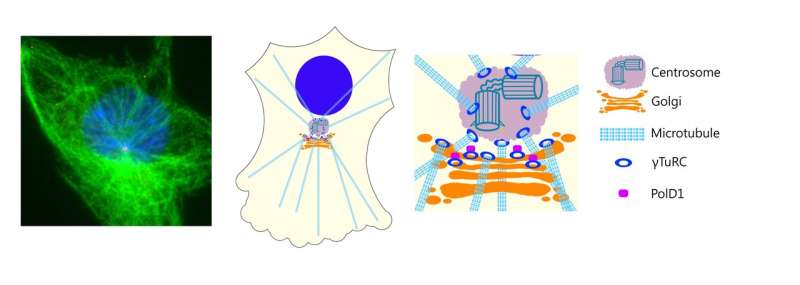Researchers reveal new insights into the control of cellular scaffold

Microtubule cytoskeleton is a major cellular scaffold that is required for dynamic organization of the cytoplasm, and the cytoskeleton plays a key role in a variety of cellular events, ranging from cell proliferation to morphogenesis. How the organization of microtubule cytoskeleton is controlled in our cells, however, has remained unclear.
Now, a research team led by Prof. Robert Qi from the Division of Life Science, The Hong Kong University of Science and Technology, has made a breakthrough in understanding how the organization of microtubule cytoskeleton is controlled. Their study revealed a previously overlooked aspect of γTuRC's regulation and demonstrated a previously unknown function of PolD1, a conserved protein that is widely recognized for its role in DNA replication and repair.
The research was published in Nature Communications on September 15, 2017.
In animal cells, the initiation of microtubule growth and subsequently the organization of microtubules into ordered arrays require γ-tubulin ring complex (γTuRCs), macromolecular assemblies that initiate the assembly of microtubule filaments. However, the mechanism by which this function of γTuRCs is controlled has thus far remained unknown.
The study found that PolD1 physically associates with γTuRCs and blocks γTuRC-induced microtubule nucleation, and that this PolD1 action is required for the control of microtubule growth at the Golgi apparatus, a major microtubule-organizing organelle that requires microtubule for its structural organization and functions.
Consequently, PolD1 regulates several Golgi activities that involve Golgi-derived microtubules, including Golgi assembly and structural organization, Golgi reorientation during cell polarization, and cell directional migration.
"Our study substantially advances the current understanding of the control of microtubule assembly mediated by γTuRCs." Said Prof. Qi, "We believe that this work would be very useful for understanding the molecular underpinnings of various microtubule-dependent cellular activities."
"PolD1 is a ubiquitously expressed protein that performs housekeeping functions in the nucleus. By revealing its function as a regulator, we are looking forward to acquire a deeper understanding on a myriad of cellular activities, such as material transports, which may provide implications on cancer and neuro disease therapies related to this protein."
More information: Yuehong Shen et al, The catalytic subunit of DNA polymerase δ inhibits γTuRC activity and regulates Golgi-derived microtubules, Nature Communications (2017). DOI: 10.1038/s41467-017-00694-2
Journal information: Nature Communications
Provided by Hong Kong University of Science and Technology

















